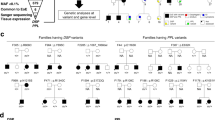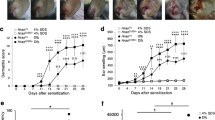Abstract
The relative contribution of immunological dysregulation and impaired epithelial barrier function to allergic diseases is still a matter of debate. Here we describe a new syndrome featuring severe dermatitis, multiple allergies and metabolic wasting (SAM syndrome) caused by homozygous mutations in DSG1. DSG1 encodes desmoglein 1, a major constituent of desmosomes, which connect the cell surface to the keratin cytoskeleton and have a crucial role in maintaining epidermal integrity and barrier function. Mutations causing SAM syndrome resulted in lack of membrane expression of DSG1, leading to loss of cell-cell adhesion. In addition, DSG1 deficiency was associated with increased expression of a number of genes encoding allergy-related cytokines. Our deciphering of the pathogenesis of SAM syndrome substantiates the notion that allergy may result from a primary structural epidermal defect.
This is a preview of subscription content, access via your institution
Access options
Subscribe to this journal
Receive 12 print issues and online access
$209.00 per year
only $17.42 per issue
Buy this article
- Purchase on Springer Link
- Instant access to full article PDF
Prices may be subject to local taxes which are calculated during checkout





Similar content being viewed by others
Accession codes
References
Menon, G.K., Cleary, G.W. & Lane, M.E. The structure and function of the stratum corneum. Int. J. Pharm. 435, 3–9 (2012).
Kubo, A., Nagao, K. & Amagai, M. Epidermal barrier dysfunction and cutaneous sensitization in atopic diseases. J. Clin. Invest. 122, 440–447 (2012).
Simpson, C.L., Patel, D.M. & Green, K.J. Deconstructing the skin: cytoarchitectural determinants of epidermal morphogenesis. Nat. Rev. Mol. Cell Biol. 12, 565–580 (2011).
Desai, B.V., Harmon, R.M. & Green, K.J. Desmosomes at a glance. J. Cell Sci. 122, 4401–4407 (2009).
Amagai, M. & Stanley, J.R. Desmoglein as a target in skin disease and beyond. J. Invest. Dermatol. 132, 776–784 (2012).
Oji, V. et al. Revised nomenclature and classification of inherited ichthyoses: results of the First Ichthyosis Consensus Conference in Soreze 2009. J. Am. Acad. Dermatol. 63, 607–641 (2010).
Milingou, M., Wood, P., Masouye, I., McLean, W.H. & Borradori, L. Focal palmoplantar keratoderma caused by an autosomal dominant inherited mutation in the desmoglein 1 gene. Dermatology 212, 117–122 (2006).
Rickman, L. et al. N-terminal deletion in a desmosomal cadherin causes the autosomal dominant skin disease striate palmoplantar keratoderma. Hum. Mol. Genet. 8, 971–976 (1999).
Keren, H., Bergman, R., Mizrachi, M., Kashi, Y. & Sprecher, E. Diffuse nonepidermolytic palmoplantar keratoderma caused by a recurrent nonsense mutation in DSG1. Arch. Dermatol. 141, 625–628 (2005).
Hershkovitz, D., Lugassy, J., Indelman, M., Bergman, R. & Sprecher, E. Novel mutations in DSG1 causing striate palmoplantar keratoderma. Clin. Exp. Dermatol. 34, 224–228 (2009).
Bergman, R. et al. Disadhesion of epidermal keratinocytes: a histologic clue to palmoplantar keratodermas caused by DSG1 mutations. J. Am. Acad. Dermatol. 62, 107–113 (2010).
Amagai, M., Ishii, K., Takayanagi, A., Nishikawa, T. & Shimizu, N. Transport to endoplasmic reticulum by signal peptide, but not proteolytic processing, is required for formation of conformational epitopes of pemphigus vulgaris antigen (Dsg3). J. Invest. Dermatol. 107, 539–542 (1996).
Hanifin, J.M., Butler, J.M. & Chan, S.C. Immunopharmacology of the atopic diseases. J. Invest. Dermatol. 85, (suppl. 1) 161s–164s (1985).
Sandilands, A. et al. Comprehensive analysis of the gene encoding filaggrin uncovers prevalent and rare mutations in ichthyosis vulgaris and atopic eczema. Nat. Genet. 39, 650–654 (2007).
Schuttelaar, M.L. et al. Filaggrin mutations in the onset of eczema, sensitization, asthma, hay fever and the interaction with cat exposure. Allergy 64, 1758–1765 (2009).
Brown, S.J. et al. Filaggrin haploinsufficiency is highly penetrant and is associated with increased severity of eczema: further delineation of the skin phenotype in a prospective epidemiological study of 792 school children. Br. J. Dermatol. 161, 884–889 (2009).
Chavanas, S. et al. Mutations in SPINK5, encoding a serine protease inhibitor, cause Netherton syndrome. Nat. Genet. 25, 141–142 (2000).
Oji, V. et al. Loss of corneodesmosin leads to severe skin barrier defect, pruritus, and atopy: unraveling the peeling skin disease. Am. J. Hum. Genet. 87, 274–281 (2010).
Ishida-Yamamoto, A., Igawa, S. & Kishibe, M. Order and disorder in corneocyte adhesion. J. Dermatol. 38, 645–654 (2011).
Hovnanian, A. Netherton syndrome: skin inflammation and allergy by loss of protease inhibition. Cell Tissue Res. 351, 289–300 (2013).
Descargues, P. et al. Corneodesmosomal cadherins are preferential targets of stratum corneum trypsin- and chymotrypsin-like hyperactivity in Netherton syndrome. J. Invest. Dermatol. 126, 1622–1632 (2006).
Descargues, P. et al. Spink5-deficient mice mimic Netherton syndrome through degradation of desmoglein 1 by epidermal protease hyperactivity. Nat. Genet. 37, 56–65 (2005).
Getsios, S. et al. Desmoglein 1–dependent suppression of EGFR signaling promotes epidermal differentiation and morphogenesis. J. Cell Biol. 185, 1243–1258 (2009).
Strid, J., Sobolev, O., Zafirova, B., Polic, B. & Hayday, A. The intraepithelial T cell response to NKG2D-ligands links lymphoid stress surveillance to atopy. Science 334, 1293–1297 (2011).
Bonnart, C. et al. Elastase 2 is expressed in human and mouse epidermis and impairs skin barrier function in Netherton syndrome through filaggrin and lipid misprocessing. J. Clin. Invest. 120, 871–882 (2010).
Incorvaia, C. et al. Allergy and the skin. Clin. Exp. Immunol. 153 (suppl. 1), 27–29 (2008).
Leyva-Castillo, J.M., Hener, P., Jiang, H. & Li, M. TSLP produced by keratinocytes promotes allergen sensitization through skin and thereby triggers atopic march in mice. J. Invest. Dermatol. 133, 154–163 (2013).
Petrof, G., Mellerio, J.E. & McGrath, J.A. Desmosomal genodermatoses. Br. J. Dermatol. 166, 36–45 (2012).
Moskowitz, D.G. et al. Pathophysiologic basis for growth failure in children with ichthyosis: an evaluation of cutaneous ultrastructure, epidermal permeability barrier function, and energy expenditure. J. Pediatr. 145, 82–92 (2004).
Fowler, A.J. et al. Nutritional status and gastrointestinal structure and function in children with ichthyosis and growth failure. J. Pediatr. Gastroenterol. Nutr. 38, 164–169 (2004).
Sprecher, E. et al. The spectrum of pathogenic mutations in SPINK5 in 19 families with Netherton syndrome: implications for mutation detection and first case of prenatal diagnosis. J. Invest. Dermatol. 117, 179–187 (2001).
Omori-Miyake, M. & Ziegler, S.F. Mouse models of allergic diseases: TSLP and its functional roles. Allergol. Int. 61, 27–34 (2012).
Li, H. & Durbin, R. Fast and accurate long-read alignment with Burrows-Wheeler transform. Bioinformatics 26, 589–595 (2010).
McKenna, A. et al. The Genome Analysis Toolkit: a MapReduce framework for analyzing next-generation DNA sequencing data. Genome Res. 20, 1297–1303 (2010).
Adzhubei, I.A. et al. A method and server for predicting damaging missense mutations. Nat. Methods 7, 248–249 (2010).
Kumar, P., Henikoff, S. & Ng, P.C. Predicting the effects of coding non-synonymous variants on protein function using the SIFT algorithm. Nat. Protoc. 4, 1073–1081 (2009).
Dusek, R.L. et al. The differentiation-dependent desmosomal cadherin desmoglein 1 is a novel caspase-3 target that regulates apoptosis in keratinocytes. J. Biol. Chem. 281, 3614–3624 (2006).
Acknowledgements
We thank S. Getsios for the use of the Zeiss Apotome. We thank D. Garrod (University of Manchester) for the kind gift of 11-5F antibody to DSP. We thank K. Stone (King's College London) for technical assistance in whole-exome sequencing. This work was supported by a generous donation of the Ram family to E.S.; US National Institutes of Health (NIH) grant RO1 AR041836 and the Joseph L. Mayberry Senior Endowment to K.J.G.; JSPS (Japan Society for the Promotion of Science) Kakenhi grant 24591620 and a grant from the Ministry of Health, Labor and Welfare of Japan to A.I.-Y.; DebRA (Dystrophic Epidermolysis Bullosa Research Association) UK to J.A.M.; the Wellcome Trust (programme grant 092530/Z/10/Z to W.H.I.M. and A.D.I. and bioresources grant 090066/B/09/Z to A.D.I. and W.H.I.M.); the National Children's Research Centre to A.D.I.; and the Pachyonychia Congenita Project to F.J.D.S. Some control sections were obtained from the Pathology Core of the Northwestern University Skin Disease Research Center (NIH grant P30AR057216). The Centre for Dermatology and Genetic Medicine at the University of Dundee is supported by a Wellcome Trust Strategic Award (098439/Z/12/Z to W.H.I.M.). L.S. is the recipient of an Excellence Award from the Tel Aviv Sourasky Medical Center.
Author information
Authors and Affiliations
Contributions
K.J.G. and E.S. jointly supervised the project and conceived and designed the experiments. L.S., O.S., R.M.H., D.R., A.I.-Y., J.L.K., W.H.I.M. and A.D.I. participated in the design of the experiments. L.S., I.G., R.S., S.G. and S.P. contributed to the phenotypic characterization of the syndrome. R.S., O.E., S.G. and S.P. contributed to biological sample collection. J.A.M. conceived and designed the exome sequencing experiments. M.A.S. carried out exome sequencing. O.S., O.I. and N.S. performed variant calling and biostatistical analysis of the exome sequencing data with contributions from M.A.S. L.S., O.S., C.S.M.G., N.J.W., F.J.D.S. and E.P. performed direct sequencing with assistance from O.E. L.S. performed PCR-RFLP. L.S. and O.S. performed RT-PCR experiments. M.H. conceived and designed the cell culture immunostaining experiments. L.S. and O.S. generated cell lines from affected individuals. L.S., R.M.H., D.R. and J.L.K. performed immunostaining of skin biopsies. A.I.-Y. performed the electron microscopic analysis of skin biopsies. A.G. performed the histopathological analysis of skin biopsies with contributions from I.G. and R.B. L.S., O.S., R.M.H., D.R., R.B., C.S.M.G., N.J.W., F.J.D.S., E.P., W.H.I.M., A.D.I., M.H., J.A.M., K.J.G. and E.S. analyzed the data. L.S., O.S., R.M.H., W.H.I.M., A.D.I., J.A.M., K.J.G. and E.S. participated in the writing of the manuscript. O.S., F.J.D.S., W.H.I.M., A.D.I., M.H., J.A.M., K.J.G. and E.S. supervised the research program.
Corresponding authors
Ethics declarations
Competing interests
The authors declare no competing financial interests.
Supplementary information
Supplementary Text and Figures
Supplementary Figures 1–4, Supplementary Tables 1–3 and Supplementary Note (PDF 793 kb)
Supplementary Data 1
Supplementary data set for Supplementary Figure 4 (XLSX 9 kb)
Source data
Rights and permissions
About this article
Cite this article
Samuelov, L., Sarig, O., Harmon, R. et al. Desmoglein 1 deficiency results in severe dermatitis, multiple allergies and metabolic wasting. Nat Genet 45, 1244–1248 (2013). https://doi.org/10.1038/ng.2739
Received:
Accepted:
Published:
Issue Date:
DOI: https://doi.org/10.1038/ng.2739
This article is cited by
-
Ichthyosis
Nature Reviews Disease Primers (2023)
-
Genetic and Molecular Contributors in Eosinophilic Esophagitis
Current Allergy and Asthma Reports (2023)
-
New developments in the molecular treatment of ichthyosis: review of the literature
Orphanet Journal of Rare Diseases (2022)
-
Epithelial barrier hypothesis and the development of allergic and autoimmune diseases
Allergo Journal International (2022)
-
Epithelial barrier hypothesis and the development of allergic and autoimmune diseases
Allergo Journal (2022)



